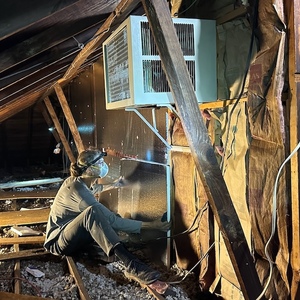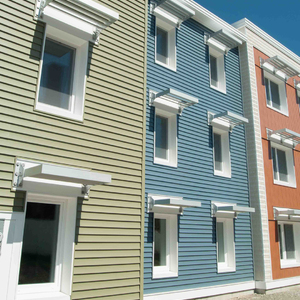
Astrieanna has an opportunity many homeowners would jump at—the chance to completely remake the interior of a 50-year-old house.
Astrieanna lives a few hours east of Vancouver, British Columbia, in a 1970s ranch over a full basement. A friend is lobbying for the complete removal of the drywall on the main floor in advance of moving a couple of non-bearing walls to improve the floor plan.
Should that be in the cards, Astrieanna already is thinking about adding insulation to both interior and exterior walls. There’s currently no insulation in interior walls, making for a noisy house.
“What else should I try to do at the same time, while the walls are all open?” she writes in this recent Q&A post. “This is my first house and it would be my first big renovation, so I’m worried that I won’t know to consider some option that is convenient while the walls are open.”
A clean slate and a homeowner who wants to do the right thing. What would you do given the same chance for wholesale improvements? That’s what this Q&A Spotlight is about.
Start with plumbing and electrical
All-new plumbing and wiring is what Ryan Lewis would do, along with installing Intello, a smart vapor retarder.
“I agree,” says Jamie B. “Plumbing and electrical improvements can have a big impact on quality of life, especially if your plumbing is older. And then you can increase capacity at that point if you want, as in increasing main diameter, adding a water line for the fridge (or future fridge that will have a water connection), washing machine (or future washing machine), his and her sinks, his and her shower heads. Add a hot water recirculation loop if you want.”
In addition to…
Weekly Newsletter
Get building science and energy efficiency advice, plus special offers, in your inbox.

This article is only available to GBA Prime Members
Sign up for a free trial and get instant access to this article as well as GBA’s complete library of premium articles and construction details.
Start Free TrialAlready a member? Log in













9 Comments
Asbestos Question:
When houses are torn down by heavy machinery, are contractors required to have the house tested for asbestos prior to the tear down? A lot of homes have been razed in my neighborhood lately, and the process creates a dust fog that is pretty amazing. I have to imagine that quite a bit of asbestos gets released considering the time period over which my neighborhood was developed.
In NH, that depends on the Town. One of my jobs involved the oldest house in that Town; new owner wanted it gone. We quoted the demo & getting the permits; when we came back on Monday, they'd rented equiptment, demo'd and semi-buried everything (boards and glass sticking up everywhere). Town said "oh, well". There is a pile of used-to-be-a-house in my Town now; my guess is no one ever checked. Yes, they should, but they won't if they can avoid it.
Another thing to consider is its a ranch! With a basement! It's pretty easy to hit everything (plumbing, wiring) from the basement or attic.
Presumably it's not a huge place - running cat 5 or coax seems like a waste too. Connect the cable box and hit everything else with Wifi.
Gutting for the sake of gutting is crazy. Spend your money on the usuals. Insulation, air sealing, more efficient equipment, PV. Nothing ""green" about throwing shit in a dumpster without a compelling reason.
"Cat5E cable, plus RG6 coaxial cable, which should be able to accommodate any need in the foreseeable future."
Cat6A should be the new standard. It's not much more and the jump from Cat6A to Cat7 is still quite steep. Running a coax cable is easy, but I'm not sure what that would ever be used for in the future. All the new set top boxes are wireless and most "cable TV" services have apps that can run on android TVs.
Cat6a (Monoprice or similar is fine) to key locations isn't an expensive idea. My new cable box actually runs on Cat6a, off the router location in another room. You don't even need to terminate the cables until needed, if you don't mind a blank single gang outlet cover on the wall. Just leave 8-10" of service loop stuffed in the gang box or mud ring cut out.
I think one run of Cat6a next to duplex power outlet at prospective TV locations is fine.
Otherwise, the wiring should run to some central location (basement, home office, pantry corner).
I still think you need RG6, Cat6a and potentially smurf tube/low volt chase to where your services come to the house. So from your home off (where you router will live) and then to the exterior were cable, fiber, etc will come in.
Always bummed to see a remodel or new construction covered on the outside by phone, data, cable wiring stapled to siding etc and holes drilled into every room of the house.
I would recommend against Cat6A. It is more expensive than Cat6 and much more difficult to work with - stiffer, heavier, special connectors and more difficult to terminate properly. If you don't have a qualified technician working with it you can end up with bad terminations that don't pass spec. The extra bandwidth is really only material if you need to run at 10G speed with longer runs (> 50m), which doesn't sound like an issue in this home.
FWIW, I know a pre-IPO systems engineer at one of the biggest tech companies in the world, building a palatial guest house in one of the more expensive neighborhoods in Silicon Valley. He has 10Gbit commercial grade service and calling him "picky" about his networking would be an understatement. He is wiring the home with Cat6 because he thinks 6A is a PITA and not worth the trouble.
Cat6a is a bit stiffer than Cat6, but it shouldn't make a difference with open walls and they both terminate with RJ45 jacks. The difference in cost for 1,000 ft of wire is like $150. Cat7 is a totally different story with metal jacks. I'm of the philosophy of putting in the most future proof for networking as reasonable since technology moves so fast with bandwidth gobbling applications.
I'm using Cat6a because because I'm wiring my own wireless access points and PoE devices. Most people who use the telco or cable co provided routers or modems should be fine with Cat6, even though it's only certified to 1 Gbps vs 10 for Cat6a. Admittedly, there are no household applications that use 1 Gbps (expect file transfer), but then again Bill Gates was rumored to say once that 640KB was adequate computer memory for the future.
Regarding noise reduction and the ultimate conclusion that it's probably best not to gut the house without good reason. I'd think where noise control is necessary, they might get acceptable results cutting holes, dense-packing the cavities with blow-in cellulose, and adding Green Glue and a second layer of drywall to one side of the partition assembly. Feasible and effective? Obviously there's going to be some re-trimming but much less than a full gut job. Certainly not as effective as resilient channels, but I'd think it'd go a long way with higher pitched sound (voices).
There doesnt really seem to be away around rewiring and adding insullation to walls that have none. I am about to tear out drywall from a 1950's house with no insulation and minimal wiring in each room. Existing wiring is cloth covered and without equipment ground. This addition and new plumbing will still be considerably cheaper than building a new house. I will spend 60k vs 150k for a sub 1500 sq foot bungalow.
Log in or become a member to post a comment.
Sign up Log in